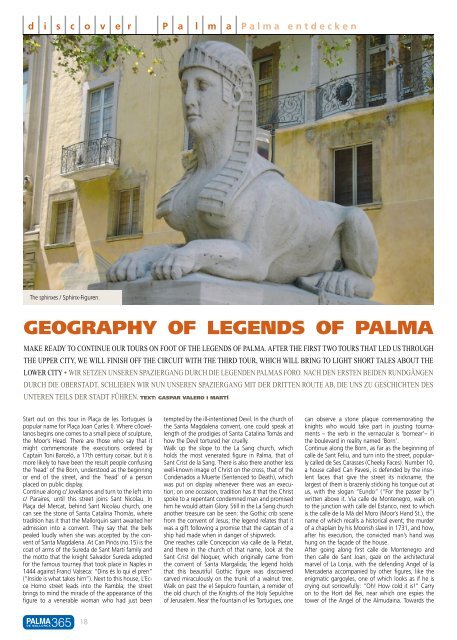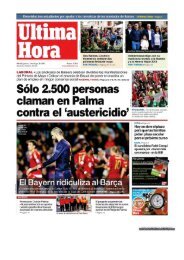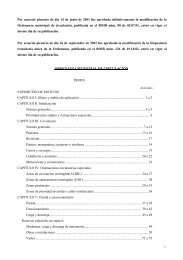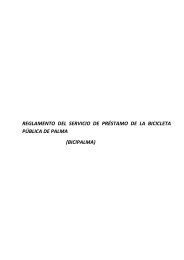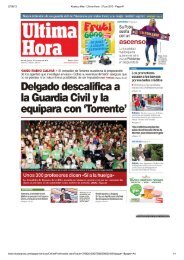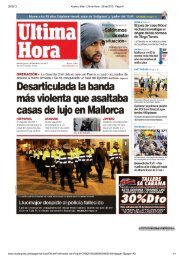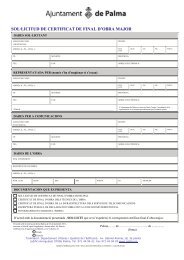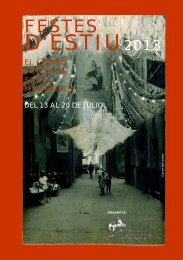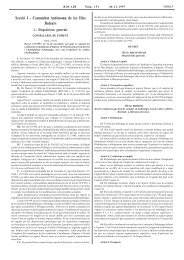e - Ajuntament de Palma
e - Ajuntament de Palma
e - Ajuntament de Palma
Sie wollen auch ein ePaper? Erhöhen Sie die Reichweite Ihrer Titel.
YUMPU macht aus Druck-PDFs automatisch weboptimierte ePaper, die Google liebt.
| d | i | s | c | o | v | e| r |ooo| P | a | l | m | a | <strong>Palma</strong> ent<strong>de</strong>cken<br />
The sphinxes / Sphinx-Figuren.<br />
GEOGRAPHY OF LEGENDS OF PALMA<br />
MAKE READY TO CONTINUE OUR TOURS ON FOOT OF THE LEGENDS OF PALMA. AFTER THE FIRST TWO TOURS THAT LED US THROUGH<br />
THE UPPER CITY, WE WILL FINISH OFF THE CIRCUIT WITH THE THIRD TOUR, WHICH WILL BRING TO LIGHT SHORT TALES ABOUT THE<br />
LOWER CITY • WIR SETZEN UNSEREN SPAZIERGANG DURCH DIE LEGENDEN PALMAS FORO. NACH DEN ERSTEN BEIDEN RUNDGÄNGEN<br />
DURCH DIE OBERSTADT, SCHLIEßEN WIR NUN UNSEREN SPAZIERGANG MIT DER DRITTEN ROUTE AB, DIE UNS ZU GESCHICHTEN DES<br />
UNTEREN TEILS DER STADT FÜHREN. TEXT: GASPAR VALERO I MARTÍ<br />
Start out on this tour in Plaça <strong>de</strong> les Tortugues (a<br />
popular name for Plaça Joan Carles I). Where c/Jovellanos<br />
begins one comes to a small piece of sculpture,<br />
the Moor’s Head. There are those who say that it<br />
might commemorate the executions or<strong>de</strong>red by<br />
Captain Toni Barceló, a 17th century corsair, but it is<br />
more likely to have been the result people confusing<br />
the ‘head’ of the Born, un<strong>de</strong>rstood as the beginning<br />
or end of the street, and the ‘head’ of a person<br />
placed on public display.<br />
Continue along c/ Jovellanos and turn to the left into<br />
c/ Paraires, until this street joins Sant Nicolau. In<br />
Plaça <strong>de</strong>l Mercat, behind Sant Nicolau church, one<br />
can see the stone of Santa Catalina Thomàs, where<br />
tradition has it that the Mallorquin saint awaited her<br />
admission into a convent. They say that the bells<br />
pealed loudly when she was accepted by the convent<br />
of Santa Magdalena. At Can Pinós (no.15) is the<br />
coat of arms of the Sureda <strong>de</strong> Sant Martí family and<br />
the motto that the knight Salvador Sureda adopted<br />
for the famous tourney that took place in Naples in<br />
1444 against Francí Valseca: “Dins és lo qui el pren”<br />
(“Insi<strong>de</strong> is what takes him”). Next to this house, L’Ecce<br />
Homo street leads into the Rambla; the street<br />
brings to mind the miracle of the appearance of this<br />
figure to a venerable woman who had just been<br />
18<br />
tempted by the ill-intentioned Devil. In the church of<br />
the Santa Magdalena convent, one could speak at<br />
length of the prodigies of Santa Catalina Tomàs and<br />
how the Devil tortured her cruelly.<br />
Walk up the slope to the La Sang church, which<br />
holds the most venerated figure in <strong>Palma</strong>, that of<br />
Sant Crist <strong>de</strong> la Sang. There is also there another less<br />
well-known image of Christ on the cross, that of the<br />
Con<strong>de</strong>nados a Muerte (Sentenced to Death), which<br />
was put on display whenever there was an execution;<br />
on one occasion, tradition has it that the Christ<br />
spoke to a repentant con<strong>de</strong>mned man and promised<br />
him he would attain Glory. Still in the La Sang church<br />
another treasure can be seen: the Gothic crib scene<br />
from the convent of Jesus; the legend relates that it<br />
was a gift following a promise that the captain of a<br />
ship had ma<strong>de</strong> when in danger of shipwreck.<br />
One reaches calle Concepcion via calle <strong>de</strong> la Pietat,<br />
and there in the church of that name, look at the<br />
Sant Crist <strong>de</strong>l Noguer, which originally came from<br />
the convent of Santa Margalida; the legend holds<br />
that this beautiful Gothic figure was discovered<br />
carved miraculously on the trunk of a walnut tree.<br />
Walk on past the el Sepulcro fountain, a remi<strong>de</strong>r of<br />
the old church of the Knights of the Holy Sepulchre<br />
of Jerusalem. Near the fountain of les Tortugues, one<br />
can observe a stone plaque commemorating the<br />
knights who would take part in jousting tournaments<br />
– the verb in the vernacular is ‘bornear’– in<br />
the boulevard in reality named ‘Born’.<br />
Continue along the Born, as far as the beginning of<br />
calle <strong>de</strong> Sant Feliu, and turn into the street, popularly<br />
called <strong>de</strong> Ses Carasses (Cheeky Faces). Number 10,<br />
a house called Can Pavesi, is <strong>de</strong>fen<strong>de</strong>d by the insolent<br />
faces that give the street its nickname; the<br />
largest of them is brazenly sticking his tongue out at<br />
us, with the slogan “Eundo” (“For the passer by”)<br />
written above it. Via calle <strong>de</strong> Montenegro, walk on<br />
to the junction with calle <strong>de</strong>l Estanco, next to which<br />
is the calle <strong>de</strong> la Mà <strong>de</strong>l Moro (Moor’s Hand St.), the<br />
name of which recalls a historical event; the mur<strong>de</strong>r<br />
of a chaplain by his Moorish slave in 1731, and how,<br />
after his execution, the convicted man’s hand was<br />
hung on the faça<strong>de</strong> of the house.<br />
After going along first calle <strong>de</strong> Montenegro and<br />
then calle <strong>de</strong> Sant Joan, gaze on the architectural<br />
marvel of La Lonja, with the <strong>de</strong>fending Angel of la<br />
Merca<strong>de</strong>ria accompanied by other figures, like the<br />
enigmatic gargoyles, one of which looks as if he is<br />
crying out sorrowfully: “Oh! How cold it is!” Carry<br />
on to the Hort <strong>de</strong>l Rei, near which one espies the<br />
tower of the Angel of the Almudaina. Towards the


